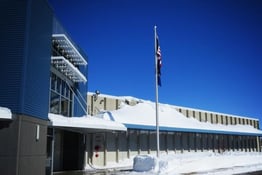This time of year can be very stressful to your roof. While most flat roofs under 40 years old have been designed for snow loads, many different variables can affect the structural performance of your roof.
Let me give you some background information about snow. Then we will give you some of the warning signs of an overloaded roof and then we will talk about solutions.
One of the main variables in determining if your roof is overloaded is in the snow itself. The weight of 1' of snow on your roof can vary from 3 pounds per square foot when there is a 'dry' snow. It can increase all the way to 21 pounds per square foot with 'wet' snow! This can make it difficult to tell what the live load of the snow is.
Another factor is that snow drifts on a roof in a similar to what it does on the ground. I have been on roofs where snow has drifted 12' high at a higher wall on the roof, the snow was blown up against the wall and it kept accumulating.
Even if you knew the snow load design for your building it is still difficult to determine the exact weight of the snow on each area of the roof. In addition to that, rain on top of a heavy snow can greatly increase the weight of the snow, this can be one of the most vulnerable times for your roof.
So what can be done? Actually quite a few things can be done. If you have a concern about snow loading then you should check these warning signs from the warm interior of your building.
First, listen for cracking, creaking or popping sounds. Talk to those working in the area to see if they've heard anything. If you have fire suppression sprinklers, see if they have sagged. It is very easy to spot in a drop ceiling area, you can see them deflect below the ceiling. Also check for bowing trusses and joists, this can be an indicator of stress. Check for doors and windows that don't open. The roof structure could be sagging and stop them from being able to be opened. Finally check for cracked or split structural members.
If you spot any of these problems, action should be taken to 'seal off' these areas so no one gets hurt. Then snow removal options should be explored. See our blog on snow removal at
http://www.glsroof.com/blog/topic/snow-removal.
One other note, drifting snow can also affect the operation of vent pipes, roof top units and water drainage when melting begins. Be sure to make sure these items are functioning properly.
Excessive snow loading can be a major problem for you and your business. If you have a concern about it follow the basic inspections mentioned and get help if you suspect a problem, your life or someone elses may be at stake.
Click here for a link to a FEMA Snow Load Safety Flyer.
If you have any questions regarding snow loading or any roofing for that matter feel free to contact us by emailing us at info@glsroof.com.




